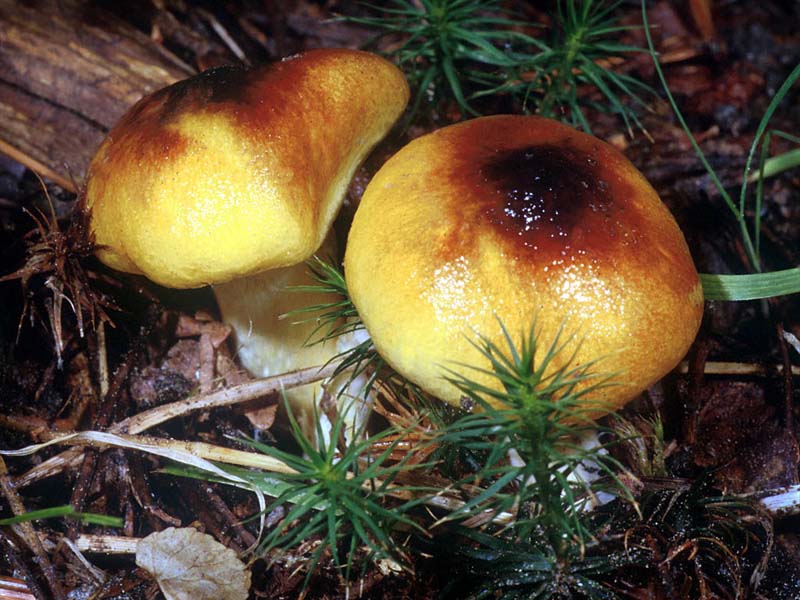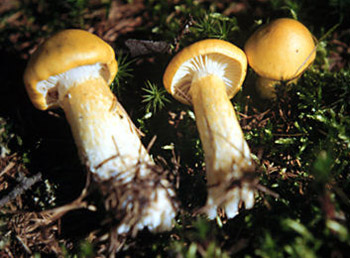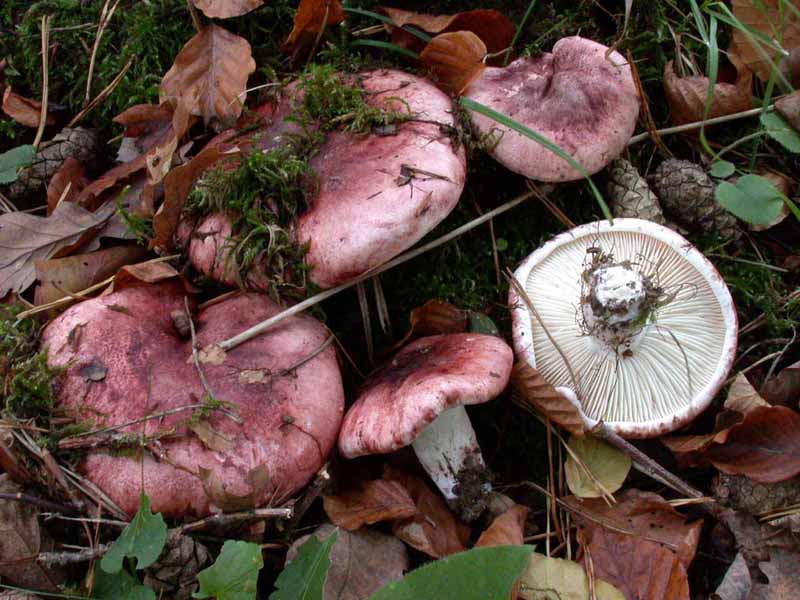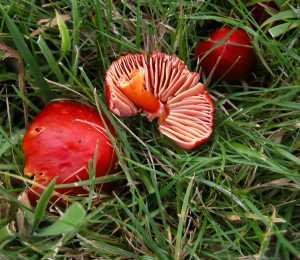Elite life

Mushrooms
Hygrophorus
║ Mushrooms ║
Hygrophorus hypothejus

Pileus: Cap 2.5-7.0 cm broad, convex, to convex-umbonate, expanding to nearly plane, the disc in age slightly umbonate or depressed; margin at first incurved to inrolled, becoming decurved, then plane to raised at maturity; surface viscid when moist, smooth to occasionally wrinkled, the disc brown to olive-brown, becoming yellow-brown to apricot-brown towards the margin; context white, soft, relatively thin; odor and taste mild.
Lamellae: Gills decurrent, subdistant, moderately thick, waxy, at first cream, becoming yellowish to peach-colored.
Stipe: Stipe 4-8 cm long, 0.5-1.2 cm thick, equal or narrowed at the base; surface at apex fibrillose, cream-yellow, sometimes pinkish to apricot; viscid-fibrillose below, pallid to colored like the cap margin; partial veil fibrillose-glutinous, leaving an evanescent slime ring high on the stipe.
Spores: Spores 7.5-10 x 4-5 μm, ellipsoid, smooth, inamyloid; spore print white.
Edibility: Edible, but untried locally.
Hygrophorus chrysodon

Cap: 3-8 cm; convex when young, becoming broadly convex, broadly bell-shaped, or more or less flat; slimy when fresh; white, overlaid with yellow to golden or orange-yellow granules along the margin; the margin at first inrolled.
Gills: Attached to the stem or running down it; distant or nearly so; white; waxy.
Stem: 3-10 cm long; up to 2 cm thick; equal above, tapering to base; when fresh sheathed with slime, at least over the lower portion; the apex dotted with granules like those on the cap margin, sometimes aggregated into an imperfect ring zone; whitish overall.
Flesh: White; unchanging; soft.
Spruce Waxy Cap (Hygrophorus pudorinus)

Pileus: Cap 6-14 cm broad, convex, expanding to plano-convex; margin at first inrolled, finely pubescent, becoming decurved to slightly raised at maturity; surface viscid when moist, glabrous, pinkish-salmon to pinkish-buff at the disc, paler at the margin; context firm, up to 4.0 cm thick at the disc, whitish, tinged pink especially near the cuticle, sometimes yellowing when bruised; odor faint, pungent; taste mild, of "mushrooms".
Lamellae: Gills subdecurrent, becoming adnate in age, close to subdistant, edges sharp, otherwise thick, intervenose, pinkish-cream; lamellulae 3-4 seried.
Stipe: Stipe 12-15 cm long, 1.5-2.0 cm thick, solid, fleshy, equal except for a pointed base, surface of apex whitish, squamulose, the lower portion dry to subviscid, fibrillose-striate, cream-colored, often flushed pink, yellowing where bruised, the base chrome-yellow; partial veil absent.
Spores: Spores 7.5-10.5 x 5.0-6.0 μm, ellipsoid to tear-shaped, smooth, thin-walled, hilar appendage inconspicuous, inamyloid; spore print white.
Edibility: Edible, but sometimes of poor quality.
Hygrophorus pustulatus

Cap 2-5 cm across, convex with a depressed center and an inrolled margin that becomes arched in maturity; gray-brown with a darker disc; sticky, glutinous when wet, with dark granular scales, especially in the center. Gills decurrent, bluntly adnate, close to subdistant, narrow; white. Stem 40-80 x 3-8 mm, solid or stuffed at the top, slightly enlarged below; whitish flushed with cap color; lower section sticky from remnants of gelatinous universal veil, elsewhere dry with some dark gray pits. Flesh soft, quite thin; white. Odor not distinctive. Taste not distinctive. Spores ellipsoid to ovoid, smooth, 7.5-9.5 x 4.5-5.5 μm. Deposit white.
Hygrophorus russula

Cap: 5-12 cm; convex or round when young, becoming broadly convex to flat; slimy, but often drying out quickly; smooth or finely hairy in places; the margin inrolled and soft or cottony, eventually unrolling; reddish to pinkish, often with streaks or spots of color; often bruising yellow in places, especially near the margin.
Gills: Attached to the stem or beginning to run down it; close; white when young, soon developing reddish spots or becoming pinkish overall.
Stem: 3-7 cm long; 1.5-3.5 cm thick; more or less equal; white at first but soon developing the colors of the cap; smooth or finely hairy; solid.
Flesh: White, or flushed with pink; thick; hard.
Red Waxy Cap, Scarlet Waxy Cap (Hygrophorus coccineus, Hygrocybe coccinea)

Pileus: Cap 2.5-5.0 cm broad, conic, becoming obtuse conic, with or without an umbo, occasionally expanding to convex or nearly plane; margin at first incurved, decurved to plane at maturity, sometimes faintly striate; surface glabrous, moist to lubricous, scarlet-red, fainter towards the margin; context up to 5.0 mm thick, soft, colored like the cap surface; odor not distinctive; taste mild.
Lamellae: Gills adnexed to notched with a descending tooth, subdistant, relatively broad and thick with a waxy aspect, intervenose, yellowish-orange, to reddish-orange, edges lighter than the faces, lamellulae up to four-seried.
Stipe 2.5-5.5 cm long, 0.5-1.0 cm thick, equal, straight to wavy, fragile, hollow, round or flattened with a groove; surface typically glabrous, only occasionally striate, moist, not viscid, colored like the cap, i.e. reddish-orange to yellowish-orange, yellowish at the base; partial veil absent.
Spores 7.0-9.5 x 4.0-5.0 μm, ellipsoid, smooth, inamyloid; spores white in deposit.
║ Mushrooms ║